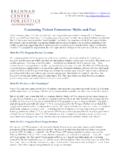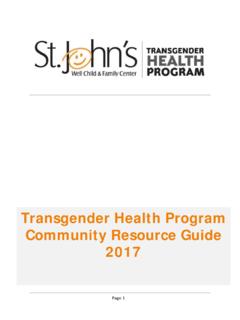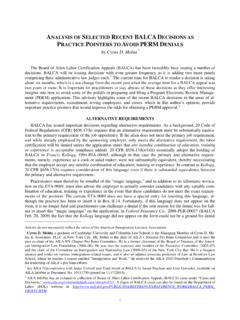Transcription of Immigration and Child Welfare
1 Children s Bureau/ACYF/ | Email: | BRIEFA pril 2015 Immigration and Child WelfareWHAT S INSIDEI mmigration and Child Welfare : Then and now Working with immigrant children and families Culturally competent practice Trauma-informed practice Conclusion ResourcesReferencesThe strengths and skills immigrants bring to the United States help weave the rich tapestry of a diverse and innovative society. As people continue to seek better lives and opportunities by coming to this country, topics surrounding Immigration are increasingly becoming a part of the national conversation, including in the field of Child Welfare . Immigrant families involved with Child Welfare may face a number of particular issues. These can include legal barriers to accessing services; Child trauma resulting from difficult Immigration or refugee experiences, extended separation from parents, or a parent s detention/deportation by Immigration authorities; acculturation and language issues; and more.
2 In order for Child Welfare professionals to provide the most useful and culturally competent services to immigrant families, it is important that they are aware of these issues and how they can impact service delivery. To that end, this issue brief addresses Child Welfare s work with immigrant children and families; examines current issues related to Immigration and Child Welfare ; provides examples of programs and promising practices; and points to resources for professionals, families, and youth. 2r015 1h5tsr:h5/w:. lw2 This material may be freely reproduced and distributed. However, when doing so, please credit Child Welfare Information Gateway. This publication is available online at and Child Welfare : Then and NowTo gain an overall perspective of the issues involved, it can be helpful for Child Welfare and related professionals to know how interactions between Child Welfare and Immigration have evolved over time. In order to best serve immigrant families today, professionals should be aware of how current Child Welfare and Immigration issues can intersect and of key legislation and directives that can impact Child Welfare Brief History of Child Welfare and ImmigrationSince its inception in 1912, the Department of Health and Human Services (HHS s) Children s Bureau has worked to ensure children and families have the support and resources they need to better their lives.
3 Often, this mission has included programs specifically for immigrant children. From pioneering activities in the 1920s that provided nutrition literature translated into numerous languages, to programs for unaccompanied children evacuated from Europe during World War II, to assistance for unaccompanied Cuban refugee children fleeing the Castro regime (HHS, 2013) in the 1960s, the Children s Bureau navigated the changing waters of Child Welfare to provide services for immigrant and refugee families and children. Throughout the subsequent decades, the field of social work and Child Welfare continued to work toward more inclusive practices and policies, with an ever-increasing emphasis on the importance of cultural awareness, the need for cultural competency training, and the recruitment of minorities into the field (Tannenbaum & Reisch, 2001). Today, Child Welfare workers face many of the same as well as some new challenges in helping immigrant children and their Welfare and Immigration TodayThe latest data released by the American Community Survey, an annual national survey conducted by the Census Bureau, estimates that there were million immigrants in the United States in 2012 (Nwosu, Batalova, & Auclair, 2014).
4 According to the Annie E. Casey Foundation s Kids Count Data Center, approximately million children in the United States, or about 24 percent of children, live in a home with at least one immigrant Kids Count Data Center. (2013). Children by family nativity. The Annie E. Casey Foundation. Retrieved from #detailed/1/any/true/868/any/445 However, of the children living with at least one immigrant parent, approximately million (or 89 percent) are Kids Count Data Center. (2014). Children in immigrant families who are citizens. The Annie E. Casey Foundation. Retrieved from #detailed/1/any/false/868,867,133,38,35/ any/12547,12548 The data available about immigrant families in Child Welfare are limited because information about Child Welfare s interactions with these families is not regularly collected at State or national levels. The National Survey of Child and Adolescent Well-Being (NSCAW), a nationwide longitudinal survey of children and families who have been investigated by Child Protective Services (CPS), provides some data about immigrant families.
5 While the overall rate of maltreatment did not differ significantly between immigrant and nonimmigrant families, immigrant children were found to be more likely to suffer from emotional abuse, while nonimmigrant children were found more likely to suffer from physical neglect (Dettlaff & Earner, 2012).The presence of certain risk and protective factors also differed sharply between immigrant and nonimmigrant families. Immigrant families tended to have a higher poverty rate than families because they often work low-wage jobs due to factors such as a lack of proficiency in English or a lower level of education (Lincroft & Dettlaff, 2010). However, they were also less likely to access services that could help alleviate some 2r015 1h5tsr:h5/w:. lw3poverty-related stressors due to several factors ( , lack of eligibility due to Immigration or legal status, fear that accessing services might bring a lack of legal status to authorities attention) (Finno-Velasquez, 2014).
6 Immigrants are also often referred to services for which they may not actually be eligible (Finno-Velasquez, 2014). Relevant Legislation and PoliciesThere are several Federal laws and other policies that can affect immigrant families eligibility for and access to public services. Child Welfare professionals who work with immigrant families should be aware of the potential impact of these laws and policies on their cases. Some key legislation, policies, and directives that Child Welfare professionals working with immigrant families should know about are Child Welfare LegislationThe Adoption and Safe Families Act (ASFA) of 1997 prioritizes the reunification of families when it is in the best interest of the Child and requires that jurisdictions make reasonable efforts to promote reunification. Immigrant families are entitled to receive reunification services; however, certain provisions of the Act may create barriers to reunification in cases involving undocumented immigrant families (Wessler, 2011).
7 For example, States are required to initiate termination of parental rights proceedings after a Child has been in foster care 15 of the previous 22 months, with some exceptions. States are able to begin these proceedings before 22 months if it is determined that a parent is not complying with the family s reunification plan (Wessler, 2011). This can be problematic for some immigrant parents because their situations may make it more difficult to comply with reunification plan requirements ( , parents who are not English proficient may not have ready access to services in their language of origin). Learn about ASFA s major provisions on Information Gateway at Fostering Connections to Success and Increasing Adoptions Act of 2008 ( 110-351) requires title IV-E agencies to identify and notify all adult relatives of a Child , within 30 days of the Child s removal, of the relatives options to become a placement resource for the Child . This should include adult relatives residing in the United States and in other countries (Park, 2014).
8 Learn more at Multiethnic Placement Act of 1994 ( 103-382) prohibits State and federally funded entities from delaying, denying, or otherwise discriminating when making a foster care or adoption placement decision on the basis of the parent or Child s race, color, or national origin. Learn more at Policies and DirectivesThe Facilitating Parental Interests in the Course of Civil Immigration Enforcement Activities Directive (Parental Interests Directive). This directive was issued by Immigration and Customs Enforcement (ICE) in 2013 for cases involving detained immigrant parents, guardians, or primary caretakers of minor children to encourage fair and humane enforcement of Immigration laws while taking into account the rights and responsibilities of the detained parents and guardians. To read an overview of the directive, visit the ICE website at Executive Actions on Immigration . Immigration policies and legislation have been much debated in recent years, and Immigration policies and procedures can often change.
9 These changes can and recently have included Executive Actions regarding Immigration policies and programs, such as Deferred Action for Childhood Arrivals, which allows deferred action from deportation for certain unauthorized immigrants who came to the United States as children. For more information onrecent Executive Actions, visit This material may be freely reproduced and distributed. However, when doing so, please credit Child Welfare Information Gateway. This publication is available online at 2r015 1h5tsr:h5/w:. lw4 Special Immigrant Juvenile Status. An Immigration classification under Federal law, Special Immigrant Juvenile Status aims to help abused, abandoned, or neglected immigrant children who are unable to be reunited with their parents stay safely in the United States. To learn about eligibility and stipulations, visit immigrant- Task Force to Strengthen CommunitiesIn November 2014, President Obama created the White House Task Force on New Americans (Task Force).
10 The goal of this interagency body representing 16 Federal departments, agencies, and White House offices is to strengthen Federal efforts toward the civic, economic, and linguistic integration of refugees and immigrants to the United States. Learn more about the Task Force by reading the White House factsheet Strengthening Communities by Welcoming all Residents and Promoting Immigrant and Refugee Integration ( ) and visiting the White House s website for the New Americans Project ( ). Read the Task Force s outline for Federal strategic goals in Strengthening Communities by Welcoming All Residents: A Federal Strategic Action Plan on Immigrant and Refugee Integration ( ). The Children s Bureau published an Information Memorandum encouraging Child Welfare agencies and related professionals to work closely with immigrant families with parents who are at risk or in the process of detention and/or deportation to help ensure their safety, stability, and well-being.


















